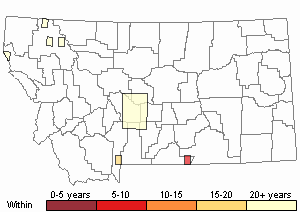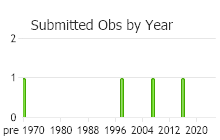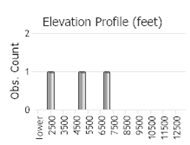View in other NatureServe Network Field Guides
NatureServe
Montana
Utah
Wyoming
Idaho
Wisconsin
British Columbia
South Carolina
Yukon
California
New York
An Orthotrichum Moss - Orthotrichum cupulatum
General Description
Plants: Acrocarpous, growing in loose clumps or cushions of upright shoots (FNA 2014), frequently mingling with other species, green, sometimes deeply so, becoming darker to blackish proximally (Lawton 1971), occasionally glaucous in densely shaded areas (Flowers 1973). Stems sometimes reaching 12 mm in height (FNA 2014), frequently forked (Lawton 1971), the branches close together (Flowers 1973).
Leaves: Straight, upright and loosely appressed when dry, spreading, sometimes broadly, when damp, 2.5-4 mm in length, lance-shaped, sometimes with ovate tendencies or leaning toward oblong, narrowing to the widely acute or rarely slightly obtuse leaf tip; leaf edges smooth, curved or rolled back nearly to the leaf apex (FNA 2014); costa almost reaching the leaf tip (Lawton 1971).
Leaf Cells: Upper laminal cells of 1 cell-layer or seldom with 2-layered strips (FNA 2014), chlorophyllous (Crum & Anderson et al., 1981), somewhat round and isodiametric (FNA 2014), sometimes elongated, thick-walled (Lawton 1971), with 2 or 3 two-lobed papillae per cell; lower laminal cells quadrangular, varying from long to short, the walls fine and not knobbed (FNA 2014).
Range Comments
North American Range
Canada: BC and ON; USA: WA, ID and MT, s to CA, AZ and CO, also SD and TX; Mexico (FNA 2014). Known in Montana from Cascade, Flathead, Gallatin, Glacier, and Judith Basin Counties (Elliott & Pipp, 2016).
Observations in Montana Natural Heritage Program Database
Number of Observations: 12
(Click on the following maps and charts to see full sized version)
Map Help and Descriptions
Relative Density

Recency



 (Observations spanning multiple months or years are excluded from time charts)
(Observations spanning multiple months or years are excluded from time charts)
Habitat
Different kinds of dry rocks, particularly limestone, in mountains and gorges (Flowers 1973); evergreen forests. Occurring from lowlands to about 9840 feet (FNA 2014).
Reproductive Characteristics
Autoicous. Seta twisted, to 1 mm tall. Capsule 1.2-1.6 mm in length, hidden amongst the perichaetial bracts to partially emerged from the perichaetial bracts (up to halfway), shrunken proximal to the opening when dry, with 16 longitudinal ribs; stomata sunken and partially covered by adjacent cells; peristome usually single and typically with a prostome in attendance; exostome of 16 upright teeth, spreading or bent back and downward with age, and generally disappearing in the aged capsule, with papillae and fine lines; endostome processes seldom present, 8 and not fully formed when present. Calyptra sheltering the full length of the capsule, with papillose hairs (FNA 2014).
Stewardship Responsibility
References
- Literature Cited AboveLegend:
 View Online Publication
View Online Publication Crum, H.A. and L.E. Anderson. 1981. Mosses of Eastern North America. 2 volumes. Columbia University Press, New York. 1328 pp.
Crum, H.A. and L.E. Anderson. 1981. Mosses of Eastern North America. 2 volumes. Columbia University Press, New York. 1328 pp. Elliott, J.C. and A.K. Pipp. 2018. A Checklist of Montana Mosses (1880-2018). Updated 3 January, 2020. Montana Natural Heritage Program, Helena, Montana. 73 pp.
Elliott, J.C. and A.K. Pipp. 2018. A Checklist of Montana Mosses (1880-2018). Updated 3 January, 2020. Montana Natural Heritage Program, Helena, Montana. 73 pp. Flora of North America Editorial Committee, eds. 2014. Flora of North America North of Mexico. Volume 28. Bryophytes: Mosses, Part 2. Oxford University Press, Inc., NY. xxi + 702 pp.
Flora of North America Editorial Committee, eds. 2014. Flora of North America North of Mexico. Volume 28. Bryophytes: Mosses, Part 2. Oxford University Press, Inc., NY. xxi + 702 pp. Flowers, S. 1973. Mosses: Utah and the West. Brigham Young University, Provo, Utah. 567 p.
Flowers, S. 1973. Mosses: Utah and the West. Brigham Young University, Provo, Utah. 567 p. Lawton, E. 1971. Moss Flora of the Pacific Northwest. Hattori Botanical Laboratory. Japan: Yamabuki-cho, Shinjuku-ku, Tokyo. 362 pages plus appendices.
Lawton, E. 1971. Moss Flora of the Pacific Northwest. Hattori Botanical Laboratory. Japan: Yamabuki-cho, Shinjuku-ku, Tokyo. 362 pages plus appendices.
- Additional ReferencesLegend:
 View Online Publication
View Online Publication
Do you know of a citation we're missing? Elliot, J. C. 1993. Second checklist of Montana mosses. Unpublished report. U.S. Forest Service, Region 1. Missoula, MT. 45 pp.
Elliot, J. C. 1993. Second checklist of Montana mosses. Unpublished report. U.S. Forest Service, Region 1. Missoula, MT. 45 pp. Lawton, E. 1971. Keys for the Identification of the Mosses on the Pacific Northwest. Reprinted from 'Moss Flora of the Pacific Northwest'. Published as Supplement No. 2 of the Journal of the Hattori Botanical Laboratory. Nichinan, Miyazaki, Japan. 66 pp.
Lawton, E. 1971. Keys for the Identification of the Mosses on the Pacific Northwest. Reprinted from 'Moss Flora of the Pacific Northwest'. Published as Supplement No. 2 of the Journal of the Hattori Botanical Laboratory. Nichinan, Miyazaki, Japan. 66 pp. Malcolm, B., N. Malcolm, J. Shevock, and D. Norris. 2009. California Mosses. Nelson, New Zealand: Micro-Optics Press. 430 pp.
Malcolm, B., N. Malcolm, J. Shevock, and D. Norris. 2009. California Mosses. Nelson, New Zealand: Micro-Optics Press. 430 pp. Smith, A.J.E. 1980. The Moss Flora of Britain and Ireland. Cambridge University Press, Cambridge. 705 pp.
Smith, A.J.E. 1980. The Moss Flora of Britain and Ireland. Cambridge University Press, Cambridge. 705 pp.
- Web Search Engines for Articles on "An Orthotrichum Moss"





